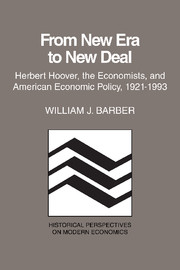Book contents
- Frontmatter
- Contents
- Preface
- Prologue: The vision of a new era in the 1920s
- 1 The ingredients of a model of a new economics
- 2 Challenges to the new economics of the 1920s
- 3 The new economics at center stage in 1929
- 4 Activating the stabilization model in late 1929 and 1930
- 5 Preliminary readings of the results of the stabilization strategy
- 6 The unraveling of the first official model in 1931
- 7 Shifting course in late 1931 and early 1932
- 8 Renewing the offensive in February and March 1932
- 9 The economists and their views on policy for 1932
- 10 Official model II as shaped in May 1932 and the aftermath
- Epilogue: Transition to the New Deal – continuities and discontinuities
- Notes
- Selected bibliography
- Index
3 - The new economics at center stage in 1929
Published online by Cambridge University Press: 19 October 2009
- Frontmatter
- Contents
- Preface
- Prologue: The vision of a new era in the 1920s
- 1 The ingredients of a model of a new economics
- 2 Challenges to the new economics of the 1920s
- 3 The new economics at center stage in 1929
- 4 Activating the stabilization model in late 1929 and 1930
- 5 Preliminary readings of the results of the stabilization strategy
- 6 The unraveling of the first official model in 1931
- 7 Shifting course in late 1931 and early 1932
- 8 Renewing the offensive in February and March 1932
- 9 The economists and their views on policy for 1932
- 10 Official model II as shaped in May 1932 and the aftermath
- Epilogue: Transition to the New Deal – continuities and discontinuities
- Notes
- Selected bibliography
- Index
Summary
No American president has come into office with a more detailed conception of what he wanted to accomplish in economic policy and of the way to go about it than did Herbert Hoover in 1929. His apprenticeship as secretary of commerce had sharpened his thinking on both strategy and tactics. The White House provided an opportunity to press forward with projects that had not yet fully matured and with some which he had pushed, but without success, as the servant of Presidents Harding and Coolidge. As president, Hoover now had a much freer hand to act, though his sense of liberation was still not complete. In his memoirs, he lamented that the public could not fully appreciate the burden an incoming president must carry when he succeeds a member of his own party. He may wish to shift course, but, as an heir who is expected to pay decent respect to his inheritance, he may be constrained from doing so too abruptly.
Setting the initial agenda for economic policy
It has become standard practice for newly elected Presidents to commission “task forces” to provide expert counsel on the challenges a new administration is likely to confront. For Hoover, a special exercise of this sort on economic policy was unnecessary. He already knew what he wanted to do. A function analogous to the latter-day task force for a president-elect was, however, performed by a study group organized under the auspices of the President's Conference on Unemployment in January 1928.
- Type
- Chapter
- Information
- From New Era to New DealHerbert Hoover, the Economists, and American Economic Policy, 1921–1933, pp. 65 - 77Publisher: Cambridge University PressPrint publication year: 1985



